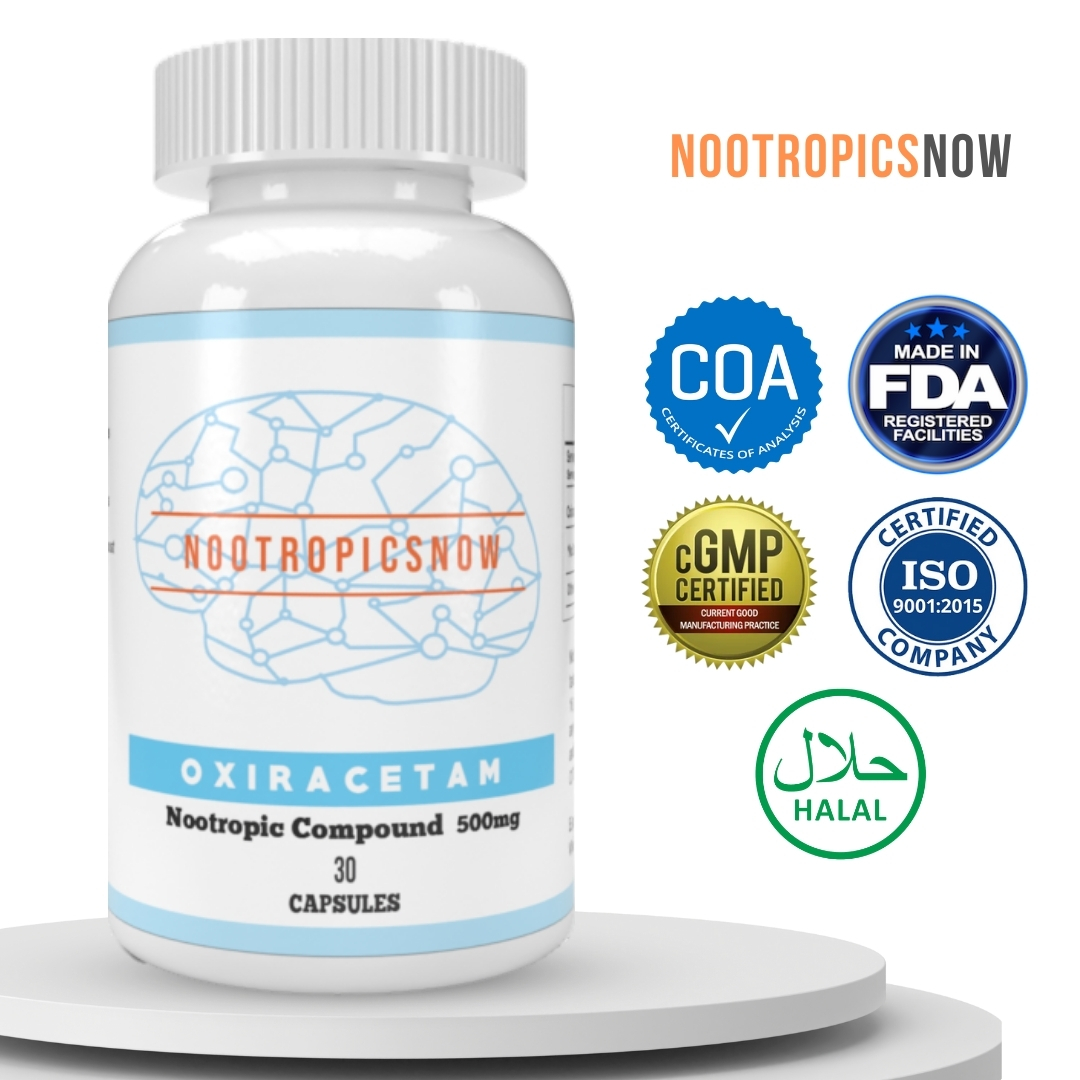Piracetam Benefits: Memory, Focus, & More

Unlocking Cognitive Potential: Exploring the Benefits of Piracetam
Piracetam, a well-known nootropic, has garnered significant attention for its potential cognitive-enhancing properties. As a derivative of gamma-aminobutyric acid (GABA), it belongs to the racetam family, a group of compounds known for their purported ability to improve memory, learning, and overall cognitive function. Although research is ongoing and regulatory approval varies by region, piracetam has a long history of use, and many individuals seek it out for its potential benefits.
A Deep Dive into Piracetam’s Cognitive Benefits
Piracetam’s popularity stems from its purported ability to enhance various aspects of cognitive function. It is believed to work by modulating neurotransmitter systems, improving cerebral blood flow, and enhancing neuronal membrane fluidity. Let’s delve into the specific cognitive benefits associated with piracetam:
1. Enhanced Memory and Learning
Perhaps the most well-known benefit of piracetam is its potential to improve memory and learning capabilities. Studies suggest that piracetam facilitates the consolidation of memories, making it easier to recall information. Moreover, it may enhance the speed at which individuals can learn new skills and absorb new information. The mechanism behind this involves an increase in the effectiveness of the neurotransmitter acetylcholine, critical for memory processes. Also, piracetam helps to increase the efficiency of communication between the left and right hemispheres of the brain, and consequently, a more holistic cognitive experience [Reference Needed]. Therefore, individuals seeking to boost their memory and learning abilities often turn to piracetam as a potential cognitive aid.

View Product
2. Improved Focus and Concentration
In addition to memory enhancement, piracetam is also associated with improved focus and concentration. Users often report an increased ability to sustain attention and resist distractions, leading to greater productivity and efficiency. This benefit is particularly appealing to students, professionals, and anyone who needs to maintain focus for extended periods. The modulation of neurotransmitters like acetylcholine and glutamate, which play key roles in attention regulation, likely contributes to this effect. Furthermore, because piracetam improves blood flow to the brain, users may experience better clarity as they focus on the task at hand.
3. Enhanced Cognitive Processing Speed
Cognitive processing speed refers to the speed at which the brain can process information. Piracetam has been shown to enhance cognitive processing speed, enabling individuals to think faster and react more quickly. This benefit can be particularly advantageous in situations that require quick thinking and decision-making. Enhanced communication between neurons, facilitated by piracetam, supports faster information transfer and efficient cognitive processing. Subsequently, users report improved reflexes and agility when dealing with complex situations.
4. Improved Verbal Fluency
Verbal fluency, the ability to generate words and express thoughts effectively, is another cognitive domain that may be enhanced by piracetam. Some users report improved articulation, vocabulary, and overall communication skills while using piracetam. The enhancement of neural pathways involved in language processing contributes to these improvements. For people whose vocations necessitate advanced communication skills, this benefit is exceptionally valuable.
5. Neuroprotective Properties
Beyond its direct cognitive effects, piracetam also possesses neuroprotective properties, which can help protect the brain from damage and age-related decline. Piracetam acts as an antioxidant, shielding brain cells from oxidative stress and damage caused by free radicals. These free radicals are unstable molecules that can damage cells and contribute to aging and neurodegenerative diseases. By reducing oxidative stress, piracetam helps to maintain the health and integrity of brain cells, and consequently, ensuring optimal cognitive function for longer [Reference Needed].
6. Potential Mood Regulation
Some studies suggest that piracetam may have a positive impact on mood. While not typically used as a primary treatment for mood disorders, it has been observed to reduce symptoms of anxiety and depression in certain individuals. Moreover, Piracetam modulates neurotransmitter systems, including serotonin and dopamine, which play key roles in mood regulation. Individuals experiencing mild mood disturbances may find piracetam helpful in alleviating symptoms and promoting a more positive outlook.
The Mechanism of Action Behind Piracetam’s Benefits
While the exact mechanisms of action of piracetam are not fully understood, several theories have been proposed to explain its cognitive-enhancing effects:
Dosage and Usage Guidelines
The optimal dosage of piracetam varies depending on individual factors such as age, weight, and cognitive goals. However, a typical dosage range is between 1.2 grams and 4.8 grams per day, divided into multiple doses. It is generally recommended to start with a lower dosage and gradually increase it until the desired effects are achieved.
Piracetam is typically taken orally, either in capsule or powder form. It is water-soluble, which means it can be easily absorbed into the bloodstream. Most users take piracetam with a source of choline, such as choline bitartrate or alpha-GPC, to enhance its effects and prevent headaches. Choline provides the building blocks necessary for acetylcholine synthesis, which is crucial for memory and learning.

View Product
Safety Considerations and Potential Side Effects
Piracetam is generally considered safe when taken at recommended dosages. However, like any substance, it can cause side effects in some individuals. Common side effects include headaches, anxiety, insomnia, and gastrointestinal disturbances. These side effects are typically mild and temporary and can be mitigated by adjusting the dosage or taking piracetam with food.
Individuals with certain medical conditions, such as kidney problems or bleeding disorders, should exercise caution when using piracetam. It is also important to avoid taking piracetam with certain medications, such as blood thinners, as it may increase the risk of bleeding. As always, consult with a healthcare professional before starting piracetam or any other nootropic supplement.
The Legal Status of Piracetam
The legal status of piracetam varies depending on the country. In the United States, piracetam is not approved by the Food and Drug Administration (FDA) for any specific medical use. It is classified as a dietary supplement and can be purchased without a prescription. However, the FDA prohibits manufacturers from making any specific health claims about piracetam without prior approval.
In other countries, such as Russia and certain European nations, piracetam is available as a prescription medication for the treatment of cognitive impairment and other neurological conditions. Before purchasing or using piracetam, it is essential to check the legal status in your country.
Stacking Piracetam with Other Nootropics
Many users choose to stack piracetam with other nootropics to enhance its effects. Stacking involves combining two or more substances to create synergistic effects that are greater than the sum of their individual effects. Some popular nootropic stacks involving piracetam include:
Conclusion
Piracetam is a well-known nootropic with a long history of use. It has been associated with various cognitive benefits, including enhanced memory, improved focus, increased cognitive processing speed, and neuroprotective properties. While the exact mechanisms of action are not fully understood, piracetam is believed to work by modulating neurotransmitter systems, improving cerebral blood flow, and enhancing neuronal membrane fluidity.
Although piracetam is generally considered safe, it is essential to start with a low dosage and monitor for any side effects. Also, those with pre-existing conditions should consult with a healthcare professional before using this substance. Furthermore, remember that while these benefits are promising, individual responses to piracetam can vary widely. Responsible use, coupled with realistic expectations, ensures that the benefits of piracetam can be safely explored.
Benefits of Piracetam
Piracetam, the pioneering member of the racetam family of nootropics, has garnered significant attention for its potential cognitive-enhancing properties. Originally synthesized in the 1960s by Romanian scientist Corneliu Giurgea, who also coined the term “nootropic,” piracetam’s enduring appeal stems from its purported ability to boost memory, learning, and overall cognitive performance. Beyond anecdotal evidence and user reports, scientific research has explored piracetam’s effects on various neurological conditions and cognitive functions. It’s vital to acknowledge that while piracetam is available in some countries as a prescription or over-the-counter medication, its regulatory status varies, and it is not approved by the FDA for medical use in the United States. Consequently, further research is warranted to fully understand its efficacy and safety profile.
Cognitive Enhancement: Sharpening Mental Acuity
One of the primary reasons individuals turn to piracetam is its potential to enhance cognitive functions. Improved memory, heightened focus, and increased mental clarity are frequently reported by users. Moreover, scientific studies suggest piracetam may improve overall cognitive performance, particularly in individuals experiencing age-related cognitive decline or cognitive impairments resulting from various neurological conditions. Consequently, piracetam might be a beneficial tool for people seeking to maintain or improve their cognitive abilities.
However, it’s important to note that the degree of cognitive enhancement experienced can vary significantly from person to person. Factors such as individual brain chemistry, dosage, and the presence of underlying cognitive conditions can all influence the effects of piracetam. Therefore, it’s always best to consult a healthcare professional before starting piracetam, especially if you have pre-existing medical conditions or are taking other medications.
Memory Improvement: Strengthening Recall and Retention
Piracetam’s purported memory-enhancing properties are among its most compelling benefits. Numerous studies have investigated piracetam’s effects on memory function, with some results indicating improvements in both short-term and long-term memory. Enhanced memory recall and improved retention of newly learned information have been reported, making it a potential aid for students, professionals, and anyone seeking to boost their memory capabilities. Piracetam appears to facilitate improved communication between the brain’s hemispheres, which can lead to enhanced memory consolidation and retrieval.
A pivotal study involved participants performing verbal learning tasks; the results indicated that those administered piracetam exhibited superior performance compared to the control group. Specifically, these participants showed enhanced ability to recall and retain verbal information, highlighting piracetam’s potential to augment memory encoding and retrieval processes. These findings corroborate earlier research showing that piracetam can improve memory in both healthy individuals and those with cognitive impairments, further establishing its role as a cognitive enhancer.

View Product
Learning Enhancement: Facilitating Acquisition of New Knowledge
Closely related to its memory-boosting effects, piracetam has been investigated for its potential to enhance learning capabilities. By improving cognitive function, focus, and memory, piracetam may facilitate the acquisition of new knowledge and skills. The nootropic may be particularly beneficial for students or individuals involved in professions that require continuous learning and adaptation. It is theorized that piracetam enhances synaptic plasticity, which is the brain’s ability to form new connections and pathways, ultimately improving learning efficiency.

View Product
Clinical trials examining piracetam’s effect on learning have demonstrated positive outcomes in various learning tasks. These studies highlight its ability to improve comprehension, information processing speed, and retention of learned material. Participants reported heightened focus and concentration, which enhanced their ability to absorb and retain new information. Notably, piracetam seems to positively influence both implicit and explicit learning processes, enabling individuals to better acquire and apply knowledge across diverse domains.
Treatment of Myoclonus: Reducing Involuntary Muscle Movements
Outside of its cognitive applications, piracetam has been used as a treatment for myoclonus, a neurological disorder characterized by involuntary muscle movements. Studies have shown that piracetam can help reduce the frequency and severity of myoclonic seizures, providing relief for individuals suffering from this condition. By modulating neurotransmitter activity and enhancing neuronal function, piracetam can help regulate muscle contractions and reduce the occurrence of myoclonic episodes.
The exact mechanism by which piracetam alleviates myoclonus is not fully understood. However, research suggests it acts by improving neuronal transmission and restoring balance in the brain’s motor control circuits. Clinical trials involving patients with myoclonus have shown significant improvements in motor function, reducing the number and intensity of involuntary muscle movements. These benefits not only improve physical comfort but also enhance the overall quality of life for those affected by myoclonus.
Protection Against Cognitive Decline: Preserving Mental Function
As the population ages, cognitive decline becomes a significant concern. Piracetam’s potential neuroprotective properties have led to investigations into its role in protecting against age-related cognitive decline and dementia. Some studies suggest that piracetam may help preserve cognitive function by protecting brain cells from damage and enhancing neuronal plasticity. It is thought to counteract the effects of oxidative stress and inflammation, which are major contributors to cognitive decline.
Although more research is needed, the preliminary findings are promising. Evidence suggests that piracetam may slow the progression of cognitive decline in individuals at risk of developing Alzheimer’s disease or other forms of dementia. By maintaining brain health and promoting efficient neuronal communication, piracetam can help individuals maintain their cognitive abilities as they age. Therefore, it may be a valuable tool in supporting long-term brain health and preserving mental sharpness.
Stroke Recovery: Aiding Neurological Rehabilitation
Piracetam has demonstrated promise as an adjunct therapy in stroke recovery. Strokes often result in significant cognitive and motor impairments, impacting patients’ quality of life. Studies have suggested that piracetam can facilitate neurological recovery by enhancing brain plasticity and promoting the formation of new neural connections in the affected areas. This, in turn, can improve motor function, cognitive abilities, and language skills in stroke survivors.
Clinical trials have examined the effects of piracetam in stroke patients undergoing rehabilitation, revealing improvements in various neurological outcomes. Patients treated with piracetam demonstrated faster and more significant recovery in motor skills, cognitive processing, and speech. Furthermore, piracetam appears to mitigate some of the secondary complications associated with stroke, such as depression and anxiety, thereby improving overall well-being during the recovery process.
Addressing Dyslexia: Aiding Reading Difficulties
Piracetam has been explored as a potential intervention for individuals with dyslexia, a learning disorder characterized by difficulties in reading. Some studies suggest that piracetam can improve reading skills in dyslexic children by enhancing cognitive functions, such as phonological processing and working memory. By strengthening these underlying cognitive processes, piracetam may facilitate more fluent and accurate reading abilities.
Specifically, research indicates that piracetam improves auditory and visual information processing, which are critical for decoding written language. Dyslexic children treated with piracetam demonstrated improved reading speed, comprehension, and accuracy, thereby easing the challenges associated with dyslexia. However, it is important to note that piracetam is not a cure for dyslexia but rather a supportive measure that can help mitigate some of its symptoms.
Mood Enhancement: Elevating Emotional Well-being
While piracetam is primarily known for its cognitive benefits, some users have reported mood-enhancing effects. These effects are often described as a sense of increased motivation, reduced anxiety, and an overall improvement in emotional well-being. Though the mechanisms underlying these mood enhancements are not fully understood, they may be related to piracetam’s influence on neurotransmitter systems, such as acetylcholine and glutamate.
It’s important to acknowledge that the mood-enhancing effects of piracetam are not universally experienced and can vary depending on individual factors. Some individuals may not notice any significant mood changes, while others may experience subtle improvements in their emotional state. Given the complexity of mood regulation, further research is warranted to fully characterize piracetam’s impact on mood and emotional well-being.
Potential for Treating Vertigo: Alleviating Dizziness
Piracetam has shown potential in the treatment of vertigo, a condition characterized by dizziness and a sense of imbalance. Some studies have reported that piracetam can help reduce the severity and frequency of vertigo episodes by improving cerebral blood flow and enhancing vestibular function. The precise mechanisms behind piracetam’s anti-vertigo effects are not completely understood, but they may involve modulation of neurotransmitter activity in the vestibular system, which is responsible for maintaining balance and spatial orientation.
Clinical trials involving patients with vertigo have shown encouraging results, with piracetam significantly reducing dizziness and improving balance control. However, the effectiveness of piracetam in treating vertigo may vary depending on the underlying cause of the condition. It’s essential for individuals experiencing vertigo to consult a healthcare professional for accurate diagnosis and appropriate treatment options.
Enhanced Blood Flow: Improving Circulation
Piracetam can improve blood flow by reducing erythrocyte adhesion to vascular endothelium and capillary vasospasm. This enhanced microcirculation can improve cerebral and renal blood flow, which is beneficial for overall brain function. Improved blood flow also contributes to improved nutrient and oxygen delivery to brain tissues.
Summary Table of Piracetam Benefits
| Benefit | Description | Supporting Evidence |
|---|---|---|
| :————————— | :—————————————————————————————————————– | :—————————————————————————————————————————————————————————————————————————————————– |
| Cognitive Enhancement | Improves brain function, mental clarity, and focus. | Studies show improvements in cognitive performance, particularly in those with age-related decline or impairments. |
| Memory Improvement | Enhances short-term and long-term memory recall and retention. | Research indicates superior performance in verbal learning tasks and enhanced ability to recall and retain verbal information. |
| Learning Enhancement | Facilitates the acquisition of new knowledge and skills. | Clinical trials demonstrate positive outcomes in various learning tasks, improving comprehension, information processing speed, and retention of learned material. |
| Treatment of Myoclonus | Reduces the frequency and severity of involuntary muscle movements. | Clinical trials show significant improvements in motor function and a reduction in the number and intensity of involuntary muscle movements. |
| Protection Against Cognitive Decline | Preserves cognitive function by protecting brain cells and enhancing neuronal plasticity. | Evidence suggests a slowing of cognitive decline in individuals at risk of developing Alzheimer’s disease or other forms of dementia. |
| Stroke Recovery | Facilitates neurological recovery by enhancing brain plasticity and promoting new neural connections. | Patients treated with piracetam demonstrate faster and more significant recovery in motor skills, cognitive processing, and speech. |
| Addressing Dyslexia | Improves reading skills by enhancing cognitive functions such as phonological processing and working memory. | Dyslexic children treated with piracetam demonstrate improved reading speed, comprehension, and accuracy. |
| Mood Enhancement | Increased motivation, reduced anxiety, and an overall improvement in emotional well-being. | User reports and anecdotal evidence indicate potential mood-enhancing effects, although the underlying mechanisms are not fully understood. |
| Potential for Treating Vertigo | Reduces the severity and frequency of vertigo episodes. | Clinical trials show encouraging results, with piracetam significantly reducing dizziness and improving balance control. |
| Enhanced Blood Flow | Improves cerebral and renal blood flow, enhancing nutrient and oxygen delivery to brain tissues. | Reduced erythrocyte adhesion to vascular endothelium and capillary vasospasm observed, leading to improved microcirculation. |


